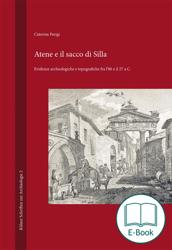The work investigates the building history of Athens between the siege and ransacking by Sulla in 86 BC and the establishment of the province of Archaia in AD 27.
After an introductory chapter about the historical background of the event, each one of the following chapters analyses a different area of the city. Furthermore, the rich appendixes either provide an integration to the main topic or collect sources and materials.
On the basis of the present study, which analysed destructions and restorations of the buildings of the entire city within the fortification wall with special reference to the main complexes, it is now possible to shed new light on the ransacking process and to restore the image of the city before the augustan building policy.
The work investigates the building history of Athens between the siege and ransacking by Sulla in 86 BC and the establishment of the province of Archaia in AD 27. This well-defined period was chosen to achieve two objectives: first, to analyse the effects of the destruction caused by the Roman siege and pillage and secondly, to reconstruct the state of the city after the siege and before the Augustan era. With the help of a thorough analysis of the literary, epigraphic and archaeological sources, an incident that had already been well known from an historical and economic perspective was freshly examined from an archaeological and topographical viewpoint in order to gain an impression of the overall picture of Athens in the last period before the Roman Imperial era.
A critical assessment of all sources had been lacking up to now - a gap that this study wants to fill.
After an introductory chapter about the historical background of the event, each one of the following chapters analyses a different area of the city. Furthermore, the rich appendixes either provide an integration to the main topic or collect sources and materials.
On the basis of the present study, which analysed the entire city within the fortification wall with special reference to the main complexes, it is now possible to shed new light on the ransacking process.
It can also be stated that according to the present analysis, it is no longer possible to regard the sack of Athens as a fixed date in the history of each monument, or as an important turning point in the building history of the city as a whole and the starting point of the Romanisation of the city. The change, or rather the development of Athens from the late Hellenistic to the Roman period iss causally related to Romanisation. However, Romanisation should be seen as a meeting and merging of two different cultures rather than as the result of a singular traumatic event. According to the results of this study, the most important turning point in this development was the establishment of the Roman Empire and the Roman province of Achaia, which led to a change of forces previously in equilibrium.
„This important book is the product of an immense quantity of research, from which the author has drawn interesting reflections and conclusions. Without a doubt there may be future nuances in interpreting the evidence, but the substance of this book would be difficult indeed to ignore.“
Von Leena Pietilä-Castrén
In: Arctos 55, 2021, S. 439-440
Caterina Parigi born 1985
2004–2009 Student, Classical Archaeology, Università degli Studi di Firenze and Ludwig-Maximilians-Universität München
2009 Master's degree, Thesis: "The Tholos and the Southwestern Buildings of the Agora in Athens," Advisor: Prof. Vincenzo Saladino (Università degli Studi di Firenze)
2011–2014 Doctoral student, Classical Archaeology, Università degli Studi di Roma Tor Vergata and Ruprecht-Karls-Universität Heidelberg
since 06/2015 Research fellow, Archaeological Institute, University of Cologne
since 11/2017 Research fellow, DFG Project "Skulpturenausstattung und Architekturdekor der Villen von Oplontis”
Research Interests: Ancient Sculpture and Collections of sculptures; Topography of Athens; Romanization
In der Reihe “Kölner Schriften zur Archäologie” werden Monographien, Dissertationen und andere materialreiche Publikationen erscheinen, die im Umfeld des Archäologischen Instituts der Universität zu Köln entstanden sind oder in einem engen Zusammenhang mit den Forschungsschwerpunkten des Instituts stehen. Dabei bietet die Arbeitsstelle Digitale Archäologie und ihre Bilddatenbank ARACHNE die einzigartige Möglichkeit, das archäologische Material auf zeitgemäße Art umfassend dokumentieren und publizieren zu können. Es handelt sich also um exemplarisch bebilderte, gut lesbare wissenschaftliche Bücher, bei denen der Argumentationsgang und die Ergebnisse der archäologischen Untersuchungen in Buchform vorgelegt, aber die vollständige Materialgrundlage online in der Datenbank ARACHNE zur Verfügung gestellt werden.


 Table of Contents
Table of Contents